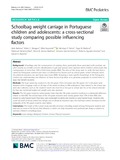Mostrar el registro sencillo del ítem
Schoolbag weight carriage in Portuguese children and adolescents: a cross-sectional study comparing possible influencing factors
| dc.creator | Barbosa, João | es_ES |
| dc.creator | Marqués, Mário C. | es_ES |
| dc.creator | Izquierdo Redín, Mikel | es_ES |
| dc.creator | Neiva, Henrique P. | es_ES |
| dc.creator | Barbosa, Tiago M. | es_ES |
| dc.creator | Ramírez Vélez, Robinson | es_ES |
| dc.creator | Alonso Martínez, Alicia | es_ES |
| dc.creator | García Hermoso, Antonio | es_ES |
| dc.creator | Aguado Jiménez, Roberto | es_ES |
| dc.creator | Marinho, Daniel | es_ES |
| dc.date.accessioned | 2019-11-25T13:16:04Z | |
| dc.date.available | 2019-11-25T13:16:04Z | |
| dc.date.issued | 2019 | |
| dc.identifier.issn | 1471-2431 | |
| dc.identifier.uri | https://hdl.handle.net/2454/35459 | |
| dc.description.abstract | Background Schoolbags and the consequences of carrying them, particularly those associated with overload, are often studied as a health concern. Modifications in gait and posture were reported when children carried loads that corresponded to more than 10% of their body weight (BW). The aims of this study were to verify the load that is carried by Portuguese students and how it is influenced by factors such as school grade, school schedule, lunch site, physical education, sex and body mass index (BMI). Acquiring a more specific knowledge of the Portuguese context and understanding the influence of these factors may allow us to generate proposals to control them in ways that benefit students.MethodsThe load carried by students in the 5th grade (10.60.4years) and 9th grade (14.70.6years) were weighed with a luggage scale on all days of the week, resulting in 680 evaluations. Data related to the school day were also collected, such as the student's lunch site, how he or she got to school and his or her school schedule for that day. Individual height and weight were also assessed. Results The 5th grade students carried greater loads than the 9th grade students, resulting in a substantial difference relative to their BW. The school loads of the 5th grade students were mostly greater than 10% of their BWs. Girls tended to carry heavier loads than boys, and overweight students also tended to carry heavier loads. Students who could eat lunch at home carried less weight, and on physical education days, the total load carried increased, but the backpacks of the 5th grade students were lighter.Conclusions The results of the current study describe excessive schoolbag weight among Portuguese students and expound on some of the factors that influence it, which can help researchers and professionals design a solution to decrease children's schoolbag loads. | en |
| dc.description.sponsorship | Funds through FCT - Portuguese Foundation for Science and Technology (UID/DTP/04045/2019) - and the European Fund for regional development (FEDER) allocated by European Union through the COMPETE 2020 Programme (POCI-01-0145-FEDER-006969), and through the Project NanoSTIMA: Macro-to-Nano Human Sensing, Towards Integrated Multimodal Health Monitoring and Analytics (NORTE-01-0145-FEDER-000016), co-financed by Fundo Europeu de Desenvolvimento Regional (FEDER) -NORTE 2020. | en |
| dc.format.extent | 7 p. | |
| dc.format.mimetype | application/pdf | en |
| dc.language.iso | eng | en |
| dc.publisher | BMC | en |
| dc.relation.ispartof | BMC Pediatrics, (2019) 19:157 | en |
| dc.rights | © The Author(s). 2019 Open Access This article is distributed under the terms of the Creative Commons Attribution 4.0 International License, which permits unrestricted use, distribution, and reproduction in any medium, provided you give appropriate credit to the original author(s) and the source, provide a link to the Creative Commons license, and indicate if changes were made. The Creative Commons Public Domain Dedication waiver (http://creativecommons.org/publicdomain/zero/1.0/) applies to the data made available in this article, unless otherwise stated. | en |
| dc.rights.uri | http://creativecommons.org/licenses/by/4.0/ | |
| dc.subject | Load carriage | en |
| dc.subject | Backpack | en |
| dc.subject | Children | en |
| dc.subject | School | en |
| dc.subject | Physical education | en |
| dc.title | Schoolbag weight carriage in Portuguese children and adolescents: a cross-sectional study comparing possible influencing factors | en |
| dc.type | info:eu-repo/semantics/article | en |
| dc.type | Artículo / Artikulua | es |
| dc.contributor.department | Ciencias de la Salud | es_ES |
| dc.contributor.department | Osasun Zientziak | eu |
| dc.rights.accessRights | info:eu-repo/semantics/openAccess | en |
| dc.rights.accessRights | Acceso abierto / Sarbide irekia | es |
| dc.identifier.doi | 10.1186/s12887-019-1519-2 | |
| dc.relation.publisherversion | https://doi.org/10.1186/s12887-019-1519-2 | |
| dc.type.version | info:eu-repo/semantics/publishedVersion | en |
| dc.type.version | Versión publicada / Argitaratu den bertsioa | es |
Ficheros en el ítem
Este ítem aparece en la(s) siguiente(s) colección(ones)
La licencia del ítem se describe como © The Author(s). 2019 Open Access This article is distributed under the terms of the Creative Commons Attribution 4.0
International License, which permits unrestricted use, distribution, and
reproduction in any medium, provided you give appropriate credit to the original author(s) and the source, provide a link to
the Creative Commons license, and indicate if changes were made. The Creative Commons Public Domain Dedication waiver
(http://creativecommons.org/publicdomain/zero/1.0/) applies to the data made available in this article, unless otherwise stated.



